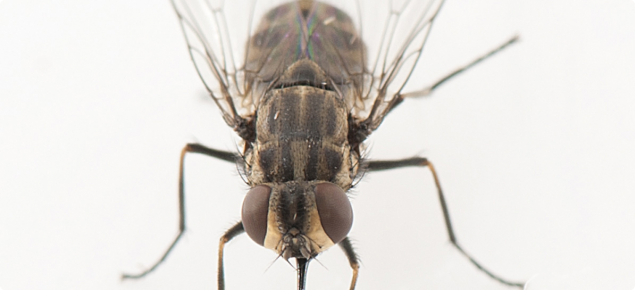One hazardous downside of using raw manure is fly breeding, which can also occur in uncovered compost heaps. Allowing flies to breed can cause a nuisance to neighbours and constitute an offence under the Fly Eradication Regulation administered by the Department of Health Act 1911.
In the metropolitan area, stable flies are a menace to livestock and pets living on the Swan Coastal Plain north and south of Perth, and everyone needs to work to minimise their breeding. Stable flies are blood-sucking insects which attack animals and humans. Composting of organic materials prevents fly breeding.
The Department of Primary Industries and Regional Development is the custodian for new regulations aimed at managing stable flies. New regulations under the Biosecurity and Agricultural Management Act are based on community consultation and research and aim to reduce fly numbers in outer metropolitan shires.
Stable fly
The stable fly feeds on blood making it a destructive pest, especially for horses and cattle, where biting can lead to agitation, weight loss and general wellbeing issues.
Stable flies breed in rotting vegetation including horticultural waste, livestock bedding and decomposing poultry manures in contact with the soil. Both male and female flies need blood to enable them to mate and lay eggs.
With the shires and cities of Wanneroo, Swan, Joondalup, Gingin, Chittering, Kalamunda, Armadale, Rockingham, Cockburn, Harvey, Kwinana, Serpentine-Jarrahdale, and part of the Shire of Murray, the transportation of poultry waste and its use as horticulture manure are banned at all times of year unless it is treated to stop stable fly breeding.
Horticultural growers should not allow crop waste to rot on the ground as it breeds stable fly. Horticultural waste fed to animals like cattle should be spread across the paddock or placed in troughs and cannot be left to rot in piles on the ground for livestock to eat.
Outbreaks of stable fly should be reported to the local shire.
Composting
Compost is an aerobically decomposed, biologically active material of largely organic origin. While it can vary in texture it is typically dark brown in colour with an earthy appearance and smell.
The composting process should be managed to ensure that temperature, oxygen and moisture are maintained within certain ranges.
A compost pile requires the correct proportion of carbon (C) for energy and nitrogen (N) for protein production. The fastest way to produce good compost is to maintain a C:N ratio by weight of around 25 to 30 parts carbon to 1 part nitrogen. Use a mix of materials as if there is excess carbon the decomposition slows down and if there is excess nitrogen the pile will smell.
Generally brown or dry materials like shredded newspaper (175:1), dry leaves (60:1), straw (75:1) and woodchips (400:1) have a high carbon content. High nitrogen materials are often known as greens and provide the proteins for the microorganisms that break down the material. Greens include grass clippings (20:1), vegetable scraps (25:1) and manures (15:1).
Manure is a very good source of N for the composting process. Take care when handling manure by wearing gloves as it may contain dangerous pathogens. Dog and cat manure could contain parasite (worm) eggs and should be avoided.
The composting process will be accelerated if branches and other bulky material are shredded.
Composting requires oxygen. This is achieved by physical turning of the compost at regular intervals.
Moisture levels are equally important for microbial growth and their activity will decline when moisture levels drop below 40%. Moisture levels above 60% can result in anaerobic decomposition and odours. In this situation, the composting time will be longer and the compost quality reduced.
Commercial composting
Commercial composting establishments aim to minimise composting times and manage the process using two phases:
- Thermophilic – hot phase. This period lasts about six to eight weeks, depending on conditions, materials and management. The temperature ranges between 55°C and 70°C. If the temperature exceeds 70°C it should be reduced by turning and aeration. These temperatures destroy weed seeds and pathogenic micro-organisms, while the beneficial microbes, responsible for organic matter breakdown, will survive.
- Mesophyllic phase. Temperatures are less than 50°C and fall over time, stabilising at 20 to 25°C. This period is usually referred to as the maturation phase and generally takes another four to six weeks.
Home composting
With small scale composting in home gardens, these high temperatures can be difficult to achieve and in these situations, composting takes much longer.
At least two compost heaps should be alternated to allow for sufficient maturing time after establishment. Regular turning and covering of the compost heaps will reduce or prevent fly breeding, since flies breed in decomposing organic material near the soil surface.
Compost tumblers (revolving drums) are commercially available and are easier to handle. Make sure that the compost is regularly wetted to keep the moisture level sufficient. A guide to adequate moisture is when you can just squeeze a little free moisture from a handful of material.
The average mature compost will have approximately 1.5% nitrogen, 0.25% phosphorus and 1% of potassium available to the plant. After application, more nutrients will become available as more organic material is broken down by micro-organisms. On sandy soils about 2kg/m2 of compost should be applied and incorporated before planting. A coarse compost used as a mulch to minimise weed growth should be applied to a depth of 50 to 75mm. Plants may still need additional nutrients after compost application. Maximum benefits from compost will only be obtained from regular, repeated use.
Other fly breeding sites
All types of rotting and decomposing organic matter are a source of fly breeding. Either compost the material or cover the heap with at least 10cm of soil to prevent fly breeding.


